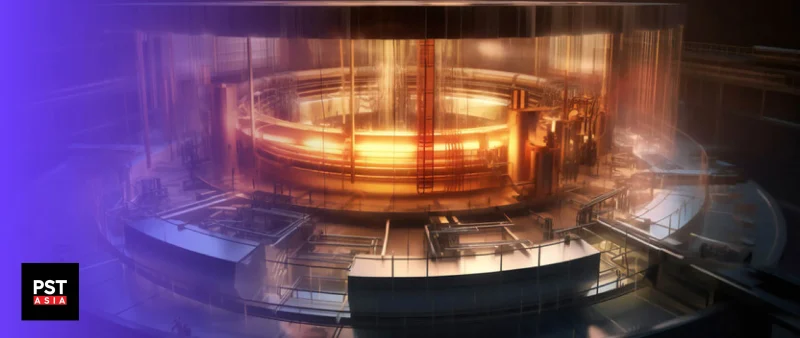In 2006, an agreement was signed by 35 countries, including the entire European Union, China, India, Japan, South Korea, Russia and the United States.
This agreement was for the construction and development of the world’s most ambitious scientific megaproject: The ITER Reactor.
So far, the project received $22 billion in investment from 35 countries, and its costs continue to increase.
The reactor is supposed to produce clean energy generated from nuclear fusion, which is the same process that makes the sun and stars shine. It is a technology still in its infancy but touted by some as the answer to humanity’s future energy needs.
However, this is easier said than done, and the ITER project is facing many difficult challenges that could bring it down despite having many global superpowers behind it.
Will this project be the future of clean energy or a costly failure?
What is the ITER Project?
The International Thermonuclear Experimental Reactor, or ITER, which means “the way” or “the path” in Latin, is an international nuclear fusion research and engineering megaproject aimed at creating energy through a fusion process similar to that of the sun.
The ITER project was called the largest and most ambitious scientific experiment ever conceived, which is perfectly justified by its size alone. The reactor weighs 23,000 tonnes and stands at nearly 30 meters tall.
When completed, this machine will essentially be a giant, high-tech, doughnut-shaped vessel that will contain hydrogen raised to very high temperatures so it becomes ionized, forming a plasma similar to plasmas in the sun. Then, powerful magnetic and electric fields flowing from and through the machine will heat the plasma cloud so that the atoms inside will collide and fuse together, releasing immense amounts of energy.
The project is located in Cadarache in the south of France, where 35 nations are collaborating to build the world’s largest tokamak, a magnetic fusion device that can be used to produce a carbon-free clean source of energy by mimicking the physics of the sun and stars.
The idea for an international joint experiment in nuclear fusion was first launched in 1985, and thousands of engineers and scientists have contributed to the design of ITER ever since.
The Members and their Contributions
The members behind the project include the European Union, China, India, Japan, South Korea, Russia and the United States. They are all actively involved in this decades-long collaboration in order to secure the future of the global energy market.
The ITER Agreement was signed in 2006 between these countries, in which they agreed to share the costs of construction, operation, and decommissioning. Also, they agreed to share the experimental results and any intellectual property generated by the fabrication, construction, and operation phases.
When it was first agreed on in 2006, it had a budget of €5 billion (then $6.3 billion) and a 10-year plan that would have seen the megaproject finished in 2016.
However, costs continued to pile up and are now estimated at €20 billion ($22 billion), and construction is expected to finish in 2025.
Europe is responsible for the largest portion of construction costs, which is 45.6%. The remaining 54.4% is shared equally by China, India, Japan, South Korea, Russia, and the U.S., with 9.1% each.
The non-European members bring in very little monetary contribution because they are more responsible for contributions in the form of completed components, systems, or buildings.
For example, in November of 2023, China managed a timely delivery of all magnet support assemblies for the ITER project, which were necessary core components that laid the foundation for the project’s first plasma discharge, a milestone of the project.
The Project’s Benefits
The ITER project fosters global collaboration and innovation and puts France and the European Union as a whole at the forefront of global fusion research. But this isn’t all, as it also had a positive economic impact on its continent.
The ITER project is delivering almost equal returns in increased gross value added, which is an economic productivity metric that measures the contribution to the economy.
Additionally, the ITER project has created 34,000 jobs from 2008 to 2017. Many European companies grew significantly because of the project, and a good example of that is the Italian company Belleli Energy, whose CEO reported that the company’s staff grew from 300 in 2010 to 1,000 in 2017 thanks to the ITER project.
Aside from its benefits to Europe, it also has benefits for the other participating countries. One of them is sharing the rights to intellectual property and experimental results, that is, 100% of the project’s rewards while only contributing 9%.
Additionally, businesses from ITER countries are getting contracted globally. An example of this is the United States’ Oxford Superconducting Technology, which was awarded over $55 million from the European Union for its participation in the project.
However, the main benefit, and the undeniably most important one, is providing the world with a source of clean energy by using nuclear fusion. This would be a dream come true since the need for an abundant source of clean energy is becoming increasingly desperate on a global scale, especially as the impacts of the climate crisis worsen with the burning of fossil fuels.
Skepticism
Even though this project has 35 countries behind it, it isn’t immune to problems and skepticism.
Physicists have been studying fusion power since the 1950s, but turning it into a practical energy source has remained frustratingly slippery and difficult.
Many experts in the field think that we’re unlikely to be able to generate large-scale energy from nuclear fusion before 2050, with the more cautious of them adding on another decade.
With the pace of the climate crisis, we need a solution for the short-term, and even though the efforts being exerted on the ITER project are good, it’s doubtful that nuclear fusion will be the savior the energy sector needs, especially since it also was delayed from 2016 to 2025, and who knows if it’ll be ready by then.
It is likely that the project will be delayed again. Many started to think so after American science writer and mathematician Charles Seife acquired internal ITER documents through a Freedom of Information Act lawsuit that was filed this year.
The documents implied that the $22 billion total cost for the project was outdated, enforcing the belief that the ITER’s remaining technical challenges are causing its budget to spiral out of control and delaying the project further into the future.
These documents were drafted a year ago for a private meeting of the ITER Council, ITER’s governing body, and they show that, at the time, the project was bracing for a three-year delay. According to Charles Seife, no one within the ITER Organization has been able to provide estimates of the additional delays, much less the extra expenses expected to result from them.
He also believes that the problems leading to these latest projected delays were several years in the making, and the ITER Organization itself mainly caused them since it was extremely slow to let on that anything was wrong.
What Went Wrong?
Cracks on the ITER project’s surface started showing six years ago.
In 2017, the ITER’s then director, the late Bernard Bigot, claimed that everything was on track and construction of the ITER complex’s foundation, which includes an earthquake protection system with hundreds of tremor-dampening rubber- and metal-laminated plates, should have been almost complete.
From there, assembly of the reactor itself was planned to begin in 2018. However, two of the reactor’s major pieces were supposed to be shipped and completed in one year, but they took three years instead.
The two pieces were completed in January and April 2020. And they weren’t the only pieces late. In fact, a large proportion of the big components of the machine were behind schedule by a year or two years or even more. This caused the official start of the assembly to move from 2018 to 2020.
And we all know what happened in 2020. Covid-19 struck the entire world, slowing down the manufacturing and shipping of machine components.
The ITER Council quietly asked for a revised schedule and estimate of costs in late 2021, which were presented in 2022, almost a month after the death of the project’s director, Bernard Bigot.
According to Laban Coblentz, ITER’s head of communications, Bigot’s death had pushed the ITER project into a “rather traumatic transition in leadership,” which effectively threw plans of the revised schedules off.
As if the late arrival of some of the ITER’s components wasn’t enough, some of that machinery also turned out to be defective.
Several thermal shields meant to keep the ITER’s liquid helium cold and protect the walls of the machine cracked because of the way the welds interacted with an acid used to wash the metal. This will be repaired by replacing about 20 kilometers of very thin piping.
Another issue involves some of the puzzle-piece-like parts of the vacuum vessel, which are intended to fit together with extreme precision but turned out to be not manufactured as precisely as needed.
This led the ITER Organization to halt the assembly of the vacuum vessel and also to remove the already installed segment for repairs in 2022.
What’s Next for the ITER Project?
Even though the project’s leaders have not publicly addressed these issues and have instead maintained an optimistic and confident tone, the ITER project is unlikely to meet its current schedule and budget targets.
It will definitely need more time and money to overcome its current challenges and perhaps even more intervention from the governments of the countries behind the project to fix its bad management.
Despite its problems, the ITER project is still an important scientific experiment. While there are several other public and private initiatives that are pursuing different approaches and technologies for achieving fusion energy, none of them have yet proven their feasibility or viability.
There is a lot at stake for the ITER project. Its success or failure will have strong implications for the future of nuclear fusion energy research, as well as for global cooperation in technology and science.
If you want to read about an artificial sun project that turned out to be a success, check out our article on China’s EAST reactor.
Disclaimer
Please visit and read our disclaimer here.









